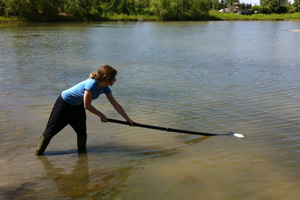UOIT Faculty of Science professor and grad student team up to help with water quality study
July 22, 2013

A faculty member and Master of Applied Bioscience student from the University of Ontario Institute of Technology (UOIT) are applying their specialized skills and knowledge in phytoplankton analysis toward a water quality project in the Sudbury, Ontario area.
Dr. Andrea Kirkwood, Assistant Professor in the Faculty of Science, is an expert in blue-green algae research and leads a program in Aquatic Ecology and Algal Biotechnology at UOIT. Supported by a grant from the Natural Sciences and Engineering Research Council of Canada (NSERC), Dr. Kirkwood and student Carrie Strangway will participate in the Lower Vermilion Source Water Quality Monitoring Project, a two-year water quality study of the Vermilion River and its watershed, by analyzing 280 phytoplankton samples collected at 20 sites and lakes along the river continuum west of Sudbury. Strangway will use the collected data for her master’s thesis, and the team will produce a data analysis report that assesses the water quality and discusses how phytoplankton analysis can help biologists draw conclusions about water quality around the Vermilion River. The findings will be published in scientific journals.
Dr. Kirkwood first heard about the Lower Vermilion Source Water Quality Monitoring Project through social media. Linda Heron, Chair of the Ontario Rivers Alliance and Chair of the Vermilion River Stewardship, had received a $103,200 grant from Ontario Trillium Foundation for the water quality study and had posted some questions on Twitter due to concerns regarding blue-green algae blooms that had been detected under the ice on the Vermilion River during the winter. An expert on blue-green algae, Dr. Kirkwood responded to Heron’s questions and offered to collaborate on the project.
“This study is very important for the management of the Vermilion River down the road,” explained Dr. Kirkwood, adding that the river system is exposed to many stresses, including mining, blue-green algae blooms, sewage treatment plants, forestry and logging. “Phytoplankton are microscopic organisms living in the water and they grow quickly, so you can see how they react to these stresses,” Dr. Kirkwood said. “We look at them as bioindicators of ecosystem health.”
With the Greater Sudbury area’s growing population and the potential expansion of mining activities in northern Ontario, the water quality study will enable the Vermilion River Stewardship to present concrete data to the Ontario government about the issues the river system may experience due to such changes. “We want to make sure they know what the system is like and what needs to be protected before more intensive mining and damming activities occur,” Dr. Kirkwood said.
Participating in the project is an opportunity of a lifetime for Strangway. “When I graduate from UOIT two years from now, I will have numerous skills that should give me an advantage when competing for jobs,” she said. As an undergraduate Research Assistant, Strangway gained some experience monitoring the water quality of storm water ponds in Durham Region. After this project, she will have the additional classical training and experience identifying algae under a microscope. “This is a great asset because not many people have this skill.” In fact, Dr. Kirkwood is one of a handful of professors who received this kind of training from her professors and still passes it on to her students.
Because of her expertise, Dr. Kirkwood has had the opportunity to collaborate on other projects, including one connected with the Central Lake Ontario Conservation Authority (CLOCA). In March, funding was approved by Oshawa City Council to allow Gage Comeau and Sabrina Bedjera, two fourth-year Biological Science thesis students, to assess the water quality of the Oshawa Creek by collecting samples every two weeks from seven different sites along the creek and its feeder streams. The students will base their thesis projects on their summer field work.
“All of that water from Oshawa Creek ends up in Lake Ontario, so we would like to improve the quality of the water going into the lake before it gets there and make the process of treating the water for drinking much easier and cheaper,” Dr. Kirkwood said. “We’re trying to be proactive and figure out where the hot spots are and the areas that need improvement.”



